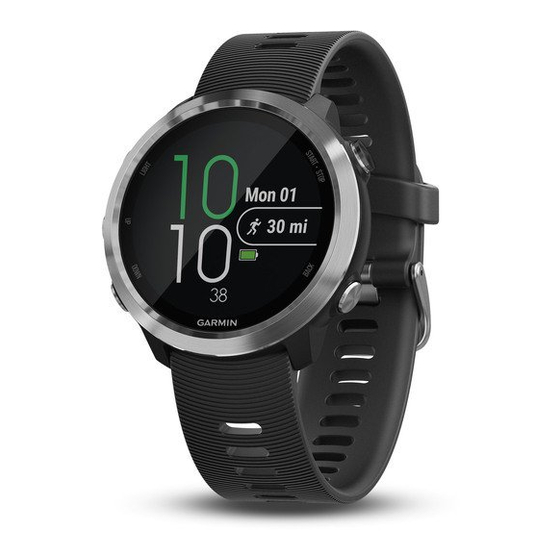Garmin FORERUNNER 645 MUSIC Manual del usuario - Página 15
Navegue en línea o descargue pdf Manual del usuario para Ver Garmin FORERUNNER 645 MUSIC. Garmin FORERUNNER 645 MUSIC 38 páginas.

EPOC is an estimate of how much energy it takes for your
body to recover after exercise.
Predicted race times: Your device uses the VO2 max. estimate
and published data sources to provide a target race time
based on your current state of fitness. This projection also
presumes you have completed the proper training for the
race.
HRV stress test: The HRV (heart rate variability) stress test
requires a Garmin chest heart rate monitor. The device
records your heart rate variability while standing still for 3
minutes. It provides your overall stress level. The scale is 1 to
100, and a lower score indicates a lower stress level.
Performance condition: Your performance condition is a real-
time assessment after 6 to 20 minutes of activity. It can be
added as a data field so you can view your performance
condition during the rest of your activity. It compares your
real-time condition to your average fitness level.
Lactate threshold: Lactate threshold requires a chest heart rate
monitor. Lactate threshold is the point where your muscles
start to rapidly fatigue. Your device measures your lactate
threshold level using heart rate data and pace.
Turning Off Performance Notifications
Performance notifications are turned on by default. Some
performance notifications are alerts that appear upon completion
of your activity. Some performance notifications appear during
an activity or when you achieve a new performance
measurement, such as a new VO2 max. estimate.
1
Hold UP.
2
Select Settings > Physiological Metrics > Performance
Notifications.
3
Select an option.
Detecting Performance Measurements Automatically
The Auto Detect feature is turned on by default. The device can
automatically detect your maximum heart rate, and lactate
threshold during an activity.
NOTE: The device detects a maximum heart rate only when
your heart rate is higher than the value set in your user profile.
1
Hold UP.
2
Select Settings > Physiological Metrics > Auto Detect.
3
Select an option.
Training Status
Training status shows you how your training affects your fitness
level and performance. Your training status is based on changes
to your training load and VO2 max. over an extended time
period. You can use your training status to help plan future
training and continue improving your fitness level.
Peaking: Peaking means that you are in ideal race condition.
Your recently reduced training load is allowing your body to
recover and fully compensate for earlier training. You should
plan ahead, since this peak state can only be maintained for
a short time.
Productive: Your current training load is moving your fitness
level and performance in the right direction. You should plan
recovery periods into your training to maintain your fitness
level.
Maintaining: Your current training load is enough to maintain
your fitness level. To see improvement, try adding more
variety to your workouts or increasing your training volume.
Recovery: Your lighter training load is allowing your body to
recover, which is essential during extended periods of hard
training. You can return to a higher training load when you
feel ready.
Unproductive: Your training load is at a good level, but your
fitness is decreasing. Your body may be struggling to
Heart Rate Features
recover, so you should pay attention to your overall health
including stress, nutrition, and rest.
Detraining: Detraining occurs when you are training much less
than usual for a week or more, and it is affecting your fitness
level. You can try increasing your training load to see
improvement.
Overreaching: Your training load is very high and
counterproductive. Your body needs a rest. You should give
yourself time to recover by adding lighter training to your
schedule.
No Status: The device needs one or two weeks of training
history, including activities with VO2 max. results from
running or cycling, to determine your training status.
Tips for Getting Your Training Status
To get the most out of the training status feature, you can try
these tips.
• Run outdoors with heart rate at least two times per week, or
ride with heart rate and power at least two times per week.
After using the device for one week, your training status
should be available.
• Record all of your fitness activities on this device, allowing it
to learn about your performance.
About VO2 Max. Estimates
VO2 max. is the maximum volume of oxygen (in milliliters) you
can consume per minute per kilogram of body weight at your
maximum performance. In simple terms, VO2 max. is an
indication of athletic performance and should increase as your
level of fitness improves. The Forerunner device requires wrist-
based heart rate or a compatible chest heart rate monitor to
display your VO2 max. estimate.
Your VO2 max. estimate appears as a number and position on
the color gauge.
Purple
Blue
Green
Orange
Red
VO2 max. data is provided by FirstBeat. VO2 max. analysis is
provided with permission from The Cooper Institute
information, see the appendix
page
29), and go to www.CooperInstitute.org.
Recovery Time
You can use your Garmin device with wrist-based heart rate or a
compatible chest heart rate monitor to display how much time
remains before you are fully recovered and ready for the next
hard workout.
NOTE: The recovery time recommendation uses your VO2 max.
estimate and may seem inaccurate at first. The device requires
you to complete a few activities to learn about your
performance.
The recovery time appears immediately following an activity.
The time counts down until it is optimal for you to attempt
another hard workout.
Superior
Excellent
Good
Fair
Poor
®
. For more
(VO2 Max. Standard Ratings,
11
